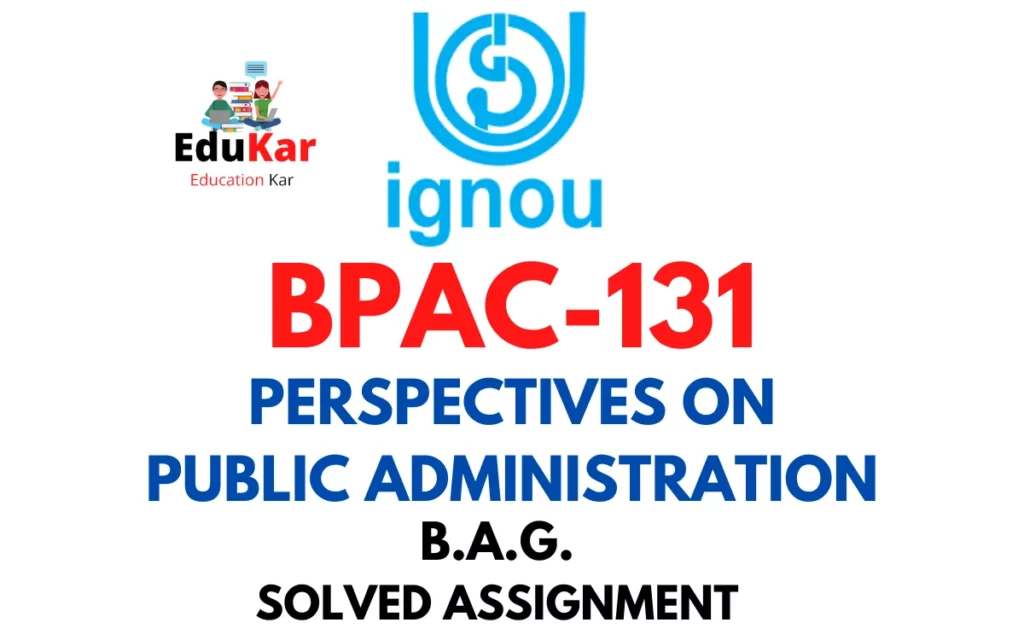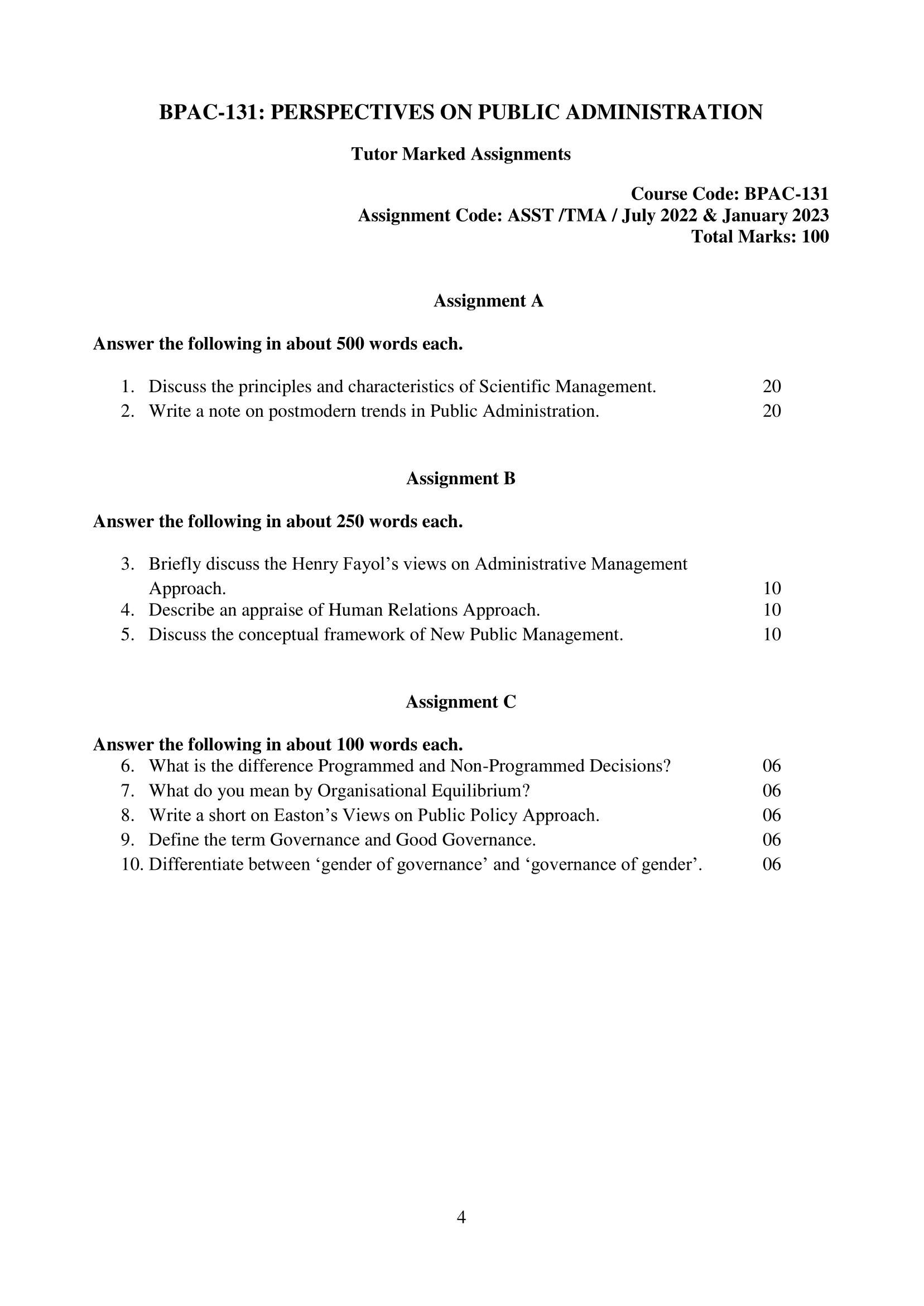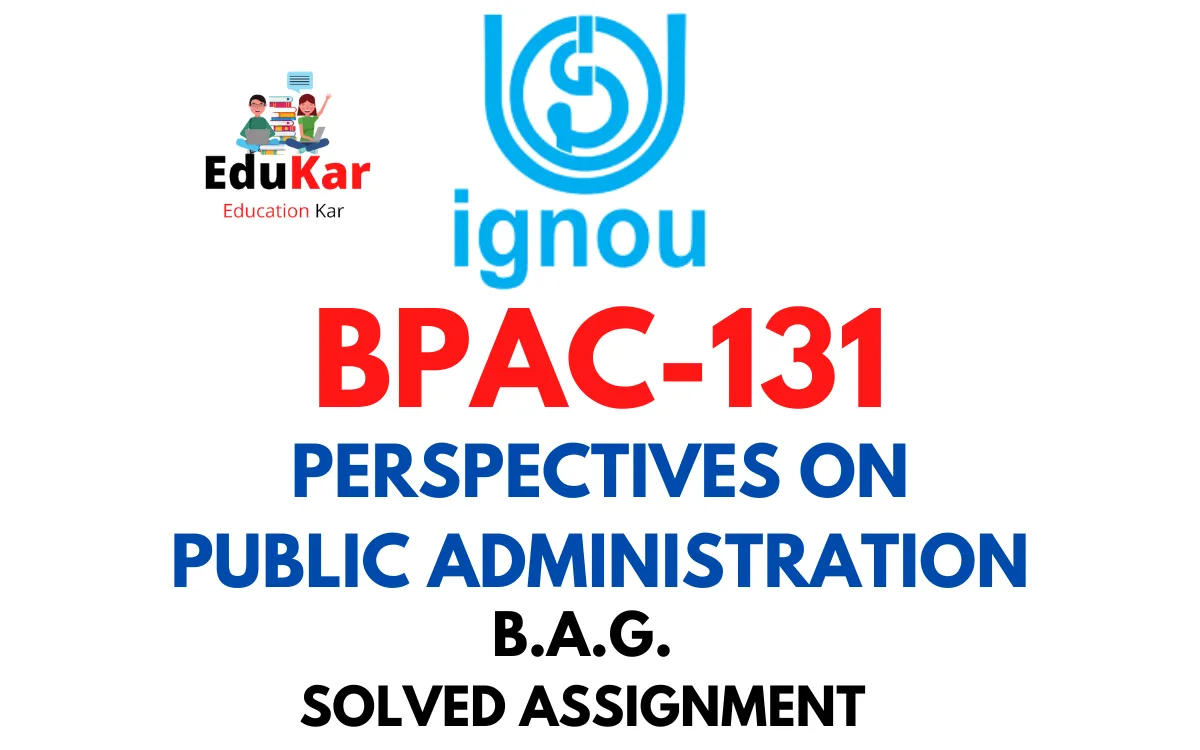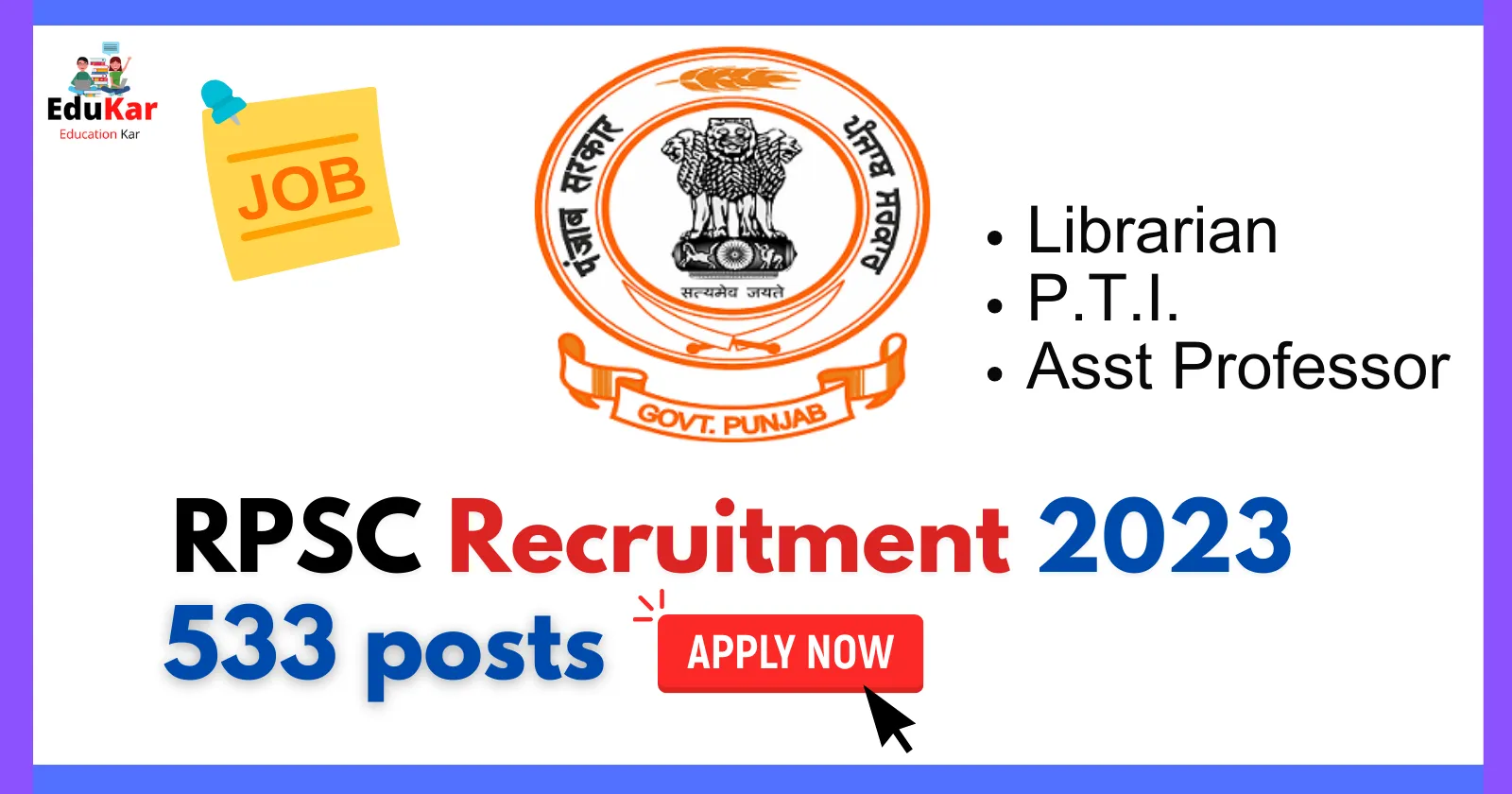
| Title | BPAC-131: IGNOU BAG Solved Assignment 2022-2023 |
| University | IGNOU |
| Degree | Bachelor Degree Programme |
| Course Code | BPAC-131 |
| Course Name | PERSPECTIVES ON PUBLIC ADMINISTRATION |
| Programme Name | Bachelor of Arts (General) |
| Programme Code | BAG |
| Total Marks | 100 |
| Year | 2022-2023 |
| Language | English |
| Assignment Code | ASST /TMA / July 2022 & January 2023 |
| Last Date for Submission of Assignment: | For June Examination: 31st April For December Examination: 30th September |

Assignment A
Answer the following in about 500 words each.
1. Discuss the principles and characteristics of Scientific Management.
Ans: Scientific Management, also known as Taylorism, is a management theory developed by Frederick Winslow Taylor in the late 19th century. It is based on the principle that work can be optimized by breaking it down into smaller tasks and analyzing them in detail to identify the most efficient way to perform each task. This theory has been widely applied in manufacturing, where it has resulted in significant improvements in productivity and efficiency. Here are the principles and characteristics of Scientific Management:
- Standardization: One of the key principles of Scientific Management is standardization, which means that tasks should be broken down into smaller components and standardized processes should be created to ensure consistency and efficiency. By standardizing processes, workers can be trained to perform their tasks in the most efficient way possible, which leads to higher productivity.
- Division of Labor: Another principle of Scientific Management is the division of labor. This means that work should be divided into smaller tasks, and each worker should be assigned a specific task that they are responsible for. This reduces the time and effort required for training and enables workers to become experts in their respective tasks.
- Time and Motion Studies: Time and motion studies are a key part of Scientific Management. These studies involve breaking down each task into its individual components and analyzing each step to determine the most efficient way to perform it. This analysis is then used to develop standardized processes that can be used to train workers.
- Scientific Selection and Training of Workers: Scientific Management emphasizes the scientific selection and training of workers. This means that workers should be selected based on their skills and abilities and trained to perform their tasks in the most efficient way possible. The training should be ongoing, and workers should be constantly monitored and evaluated to ensure that they are meeting the standards set by the organization.
- Incentive and Reward System: Scientific Management also emphasizes the use of incentives and rewards to motivate workers to perform at their best. This includes providing bonuses or other incentives to workers who meet or exceed their production targets.
The characteristics of Scientific Management can be summarized as follows:
- Emphasis on Efficiency: Scientific Management places a strong emphasis on efficiency and productivity. The goal is to maximize output while minimizing waste.
- Top-Down Decision Making: In Scientific Management, decision-making is top-down, meaning that managers make decisions and workers are expected to follow them.
- Task Specialization: Task specialization is a key characteristic of Scientific Management. Workers are assigned specific tasks that they are responsible for, and they are expected to perform those tasks in the most efficient way possible.
- Mechanistic Approach: Scientific Management takes a mechanistic approach to work, viewing it as a series of tasks that can be broken down into smaller components and analyzed to identify the most efficient way to perform each task.
- Incentives and Rewards: Scientific Management emphasizes the use of incentives and rewards to motivate workers to perform at their best.
2. Write a note on postmodern trends in Public Administration.
Ans: Postmodernism is a philosophical and cultural movement that emerged in the 20th century and has had a significant impact on various fields, including public administration. In contrast to the modernist view that knowledge is objective, universal, and based on reason and logic, postmodernism suggests that knowledge is subjective, contextual, and constructed through language and discourse. Here are some of the postmodern trends in public administration:
- Critique of Rationality: Postmodernism challenges the idea that rationality and efficiency are the most important values in public administration. Postmodernists argue that rationality is subjective and context-dependent, and that there are multiple rationalities that should be considered in decision-making.
- Emphasis on Subjectivity: Postmodernism places a strong emphasis on subjectivity, suggesting that knowledge and experience are shaped by the individual’s perspective and context. This view challenges the idea that public administrators can be objective and neutral in their decision-making.
- Focus on Diversity: Postmodernism highlights the importance of diversity and difference, suggesting that public administrators should consider the needs and perspectives of different groups in society. This approach challenges the traditional view that public administration is a value-neutral and objective field.
- Rejection of Grand Narratives: Postmodernism rejects the idea of grand narratives, or overarching theories and explanations that claim to provide a universal perspective. Instead, postmodernism suggests that knowledge is constructed through local and contextual experiences.
- Emphasis on Language and Discourse: Postmodernism places a strong emphasis on language and discourse, suggesting that meaning is constructed through the use of language. This view challenges the traditional view that language is merely a tool for conveying objective information.
- Recognition of Power Relations: Postmodernism recognizes the role of power relations in shaping public administration. This approach highlights the need to consider the ways in which power is distributed and how it affects decision-making and policy outcomes.
- Emphasis on Complexity: Postmodernism emphasizes the complexity of social issues and challenges, suggesting that simple solutions are rarely effective. This approach highlights the need for public administrators to consider the multiple factors that contribute to complex issues and to engage in collaborative problem-solving.
Assignment B
Answer the following in about 250 words each.
3. Briefly discuss the Henry Fayol’s views on Administrative Management Approach.
Ans: Henry Fayol was a French mining engineer who is widely regarded as one of the founding fathers of modern management theory. Fayol’s views on Administrative Management Approach emphasized the importance of management as a distinct and critical component of organizational success. According to Fayol, there are five key functions of management: planning, organizing, commanding, coordinating, and controlling.
Fayol argued that planning involves setting objectives, creating a roadmap to achieve those objectives, and developing strategies to overcome obstacles. Organizing involves structuring an organization in such a way that it is able to accomplish its goals effectively and efficiently. Commanding involves providing leadership and direction to subordinates, and ensuring that they are working in accordance with organizational objectives. Coordinating involves aligning the activities of different departments or teams to ensure that they are all working towards the same goals. Finally, controlling involves monitoring progress towards objectives and making necessary adjustments as needed.
Fayol believed that managers should have a broad range of skills and knowledge, including technical, human, and conceptual skills. Technical skills are the ability to understand and apply specialized knowledge related to a particular field or industry. Human skills involve the ability to work effectively with people, including communication, motivation, and teamwork. Finally, conceptual skills are the ability to think strategically and understand the complex relationships between different parts of an organization.
4. Describe an appraise of Human Relations Approach.
Ans: The Human Relations Approach to management is a theory that emerged in the 1930s and 1940s and emphasized the importance of interpersonal relationships and the role of social factors in workplace productivity and employee motivation. This approach challenged the classical management approach, which focused on maximizing efficiency and productivity through the standardization of work processes and the scientific selection of workers.
The Human Relations Approach placed greater emphasis on the social and emotional needs of workers, and recognized that factors such as communication, leadership, and social support can have a significant impact on workplace performance. This approach also recognized the importance of employee participation in decision-making, as well as the need for managers to be sensitive to the needs and concerns of their workers.
One of the key figures associated with the Human Relations Approach is Elton Mayo, who conducted the famous Hawthorne studies at the Western Electric Hawthorne Works in Chicago. These studies examined the impact of various factors, such as lighting and work breaks, on worker productivity. However, Mayo’s research ultimately demonstrated that social factors, such as the relationships between workers and their supervisors, had a greater impact on productivity than any specific work-related factor.
The Human Relations Approach has been criticized for oversimplifying the complex nature of workplace relationships and for placing too much emphasis on the emotional needs of workers. However, the approach also helped to pave the way for more modern theories of management that place greater emphasis on the importance of employee engagement, motivation, and job satisfaction.
5. Discuss the conceptual framework of New Public Management.
Ans: New Public Management (NPM) is a management theory that emerged in the 1980s and 1990s as a response to what was perceived as inefficiencies and poor performance in public sector organizations. NPM is based on a number of key principles, which together form its conceptual framework.
- Decentralization: NPM emphasizes the decentralization of decision-making power, with the aim of bringing decision-making closer to the front-line staff and the public they serve. This is achieved through the delegation of responsibilities and the creation of autonomous agencies.
- Results-based Management: NPM focuses on outcomes, and seeks to establish clear performance targets and measure progress towards achieving them. This is achieved through the use of performance indicators, benchmarking, and the use of market-style mechanisms such as contracts and competition.
- Customer Orientation: NPM places a strong emphasis on meeting the needs of customers and improving the quality of services provided. This is achieved through a focus on customer satisfaction, consultation, and the use of performance-based contracts and service level agreements.
- Efficiency and Effectiveness: NPM emphasizes the need to improve efficiency and effectiveness in the delivery of public services. This is achieved through a focus on cost control, productivity, and the use of technology and innovation to improve service delivery.
- Human Resource Management: NPM places a strong emphasis on the importance of human resource management, including the need to attract, retain, and develop a skilled and motivated workforce. This is achieved through the use of performance-based incentives, training and development, and the use of flexible work arrangements.
- Public-Private Partnerships: NPM emphasizes the importance of partnering with the private sector in the delivery of public services. This is achieved through the use of contracts, franchising, and the privatization of public services.
Assignment C
Answer the following in about 100 words each.
6. What is the difference Programmed and Non-Programmed Decisions?
Ans: Programmed decisions are those that are routine, repetitive, and can be made through established rules, policies, and procedures. These decisions are typically made by lower-level employees and do not require a great deal of analysis or judgment.
Non-programmed decisions, on the other hand, are those that are novel, unstructured, and require significant analysis, judgment, and creativity. These decisions are typically made by upper-level managers and involve a high degree of uncertainty and risk. Non-programmed decisions are often made in response to new or unexpected situations and may require significant resources and collaboration to resolve.
7. What do you mean by Organisational Equilibrium?
Ans: Organizational equilibrium refers to a state of balance or stability within an organization, where the various elements of the organization are in a state of harmony and functioning smoothly.
In this state, an organization has found an optimal balance between its various elements, such as the organizational structure, culture, processes, systems, and resources. This balance allows the organization to operate effectively and efficiently, achieving its goals and objectives while also adapting to changes in its environment.
Organizational equilibrium is not a static state but rather a dynamic one, as the organization must continuously monitor and adjust its various elements to maintain this balance. Factors that can disrupt organizational equilibrium include changes in the market, shifts in consumer demand, technological advances, changes in government regulations, and changes in the competitive landscape. Organizations that can adapt and maintain their equilibrium in response to these changes are more likely to survive and thrive in the long term.
8. Write a short on Easton’s Views on Public Policy Approach.
Ans: David Easton was a political scientist who made significant contributions to the study of public policy. Easton’s views on public policy approach can be summarized as follows:
- Systems Approach: Easton argued that public policy is best understood as a part of a larger political system, where various actors and factors interact to produce policy outcomes. He viewed public policy as a process of continuous feedback and adaptation, where various inputs, such as political preferences, economic conditions, and social norms, are processed to produce policy outputs.
- Policy Cycle: Easton proposed a policy cycle model, which consists of four stages: agenda setting, policy formulation, implementation, and evaluation. According to Easton, this model provides a useful framework for understanding the various stages of the policy process and the interactions between them.
- Policy as a Political System: Easton viewed public policy as a complex political system, where various actors, such as elected officials, interest groups, and bureaucrats, interact to produce policy outcomes. He argued that the policy system is characterized by a high degree of uncertainty, as various actors have different preferences, goals, and resources.
- Policy Feedback: Easton emphasized the importance of policy feedback, which refers to the ways in which policy outcomes can influence subsequent policy decisions. He argued that policy feedback is a crucial mechanism for maintaining policy equilibrium, as it allows policymakers to adjust policies in response to changing circumstances and feedback from stakeholders.
9. Define the term Governance and Good Governance.
Ans: Governance refers to the system by which a society or organization is managed and governed. This includes the processes, institutions, and mechanisms through which decisions are made, policies are implemented, and power is exercised.
Good governance is a term used to describe a set of principles and practices that are considered to be essential for effective, accountable, and transparent governance. These principles include, but are not limited to, participation, rule of law, transparency, accountability, responsiveness, equity, and inclusiveness.
Good governance is often seen as a key factor in promoting development, democracy, and social justice. When governance is characterized by transparency, accountability, and participation, it can help to build trust between citizens and government, and can create an enabling environment for economic growth and social development. On the other hand, when governance is characterized by corruption, lack of accountability, and exclusion, it can lead to social, economic, and political instability, and can undermine efforts to promote sustainable development and democratic governance.
10. Differentiate between ‘gender of governance’ and ‘governance of gender’.
Ans: Gender of governance’ refers to the gender composition of decision-making bodies and the extent to which women and men are represented in those bodies. This term focuses on the need for gender diversity in governance, and recognizes the important role that women can play in shaping public policy and decision-making.
‘Governance of gender’, on the other hand, refers to the ways in which governance systems and policies can either perpetuate or challenge gender inequalities. This term emphasizes the importance of ensuring that governance structures and policies are designed in ways that promote gender equity and challenge gender-based discrimination and violence.
How to Download BPAC-131 Solved Assignment?
You can download it from the www.edukar.in, they have a big database for all the IGNOU solved assignments.
Is the BPAC-131 Solved Assignment Free?
Yes this is absolutely free to download the solved assignment from www.edukar.in
What is the last submission date for BPAC-131 Solved Assignment?
For June Examination: 31st April, For December Examination: 30th October







